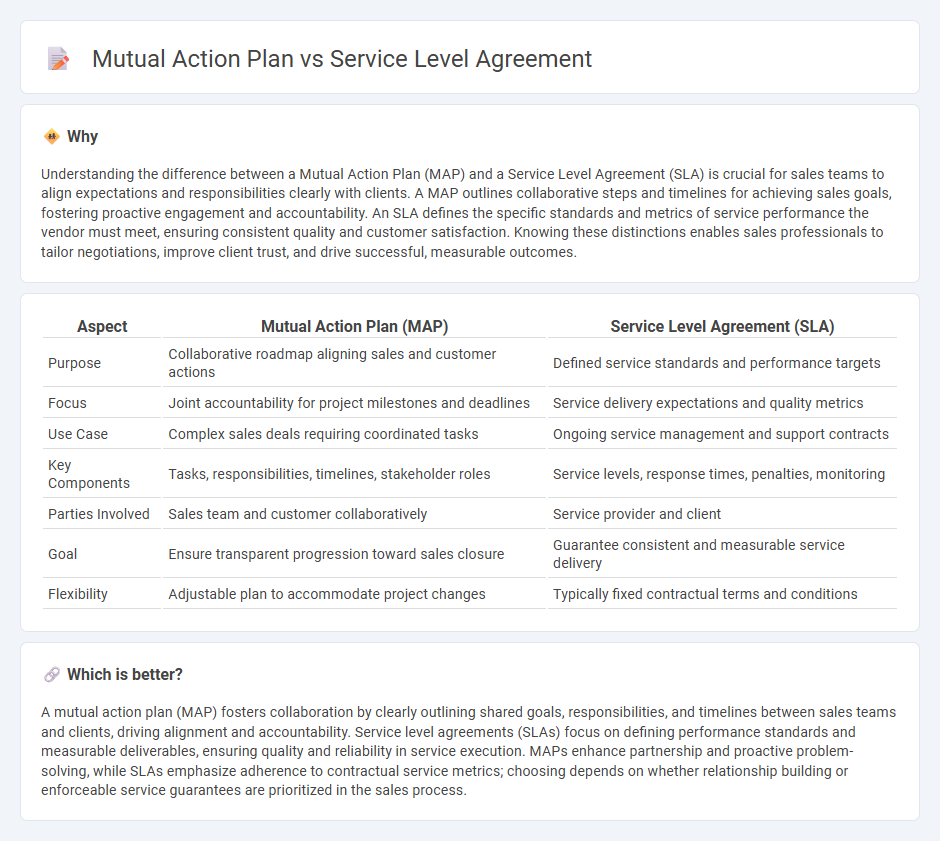
A Mutual Action Plan (MAP) outlines collaborative steps and responsibilities between sales teams and clients to achieve shared objectives within a specific timeline. A Service Level Agreement (SLA) defines measurable service standards and performance metrics that a service provider commits to delivering. Explore the key differences and benefits of MAPs and SLAs to optimize your sales strategy.
Why it is important
Understanding the difference between a Mutual Action Plan (MAP) and a Service Level Agreement (SLA) is crucial for sales teams to align expectations and responsibilities clearly with clients. A MAP outlines collaborative steps and timelines for achieving sales goals, fostering proactive engagement and accountability. An SLA defines the specific standards and metrics of service performance the vendor must meet, ensuring consistent quality and customer satisfaction. Knowing these distinctions enables sales professionals to tailor negotiations, improve client trust, and drive successful, measurable outcomes.
Comparison Table
| Aspect | Mutual Action Plan (MAP) | Service Level Agreement (SLA) |
|---|---|---|
| Purpose | Collaborative roadmap aligning sales and customer actions | Defined service standards and performance targets |
| Focus | Joint accountability for project milestones and deadlines | Service delivery expectations and quality metrics |
| Use Case | Complex sales deals requiring coordinated tasks | Ongoing service management and support contracts |
| Key Components | Tasks, responsibilities, timelines, stakeholder roles | Service levels, response times, penalties, monitoring |
| Parties Involved | Sales team and customer collaboratively | Service provider and client |
| Goal | Ensure transparent progression toward sales closure | Guarantee consistent and measurable service delivery |
| Flexibility | Adjustable plan to accommodate project changes | Typically fixed contractual terms and conditions |
Which is better?
A mutual action plan (MAP) fosters collaboration by clearly outlining shared goals, responsibilities, and timelines between sales teams and clients, driving alignment and accountability. Service level agreements (SLAs) focus on defining performance standards and measurable deliverables, ensuring quality and reliability in service execution. MAPs enhance partnership and proactive problem-solving, while SLAs emphasize adherence to contractual service metrics; choosing depends on whether relationship building or enforceable service guarantees are prioritized in the sales process.
Connection
A mutual action plan outlines the collaborative steps between sales teams and clients to achieve shared objectives, while a service level agreement (SLA) defines the specific performance standards and expectations for service delivery. Both documents align goals and responsibilities, ensuring clear communication and accountability throughout the sales process. Integrating a mutual action plan with an SLA enhances customer satisfaction by providing transparency and measurable outcomes.
Key Terms
Commitments
Service Level Agreements (SLAs) define specific, measurable commitments between service providers and clients, emphasizing performance metrics, response times, and accountability for service delivery. Mutual Action Plans (MAPs) outline collaborative commitments, detailing shared responsibilities and milestones to achieve mutual goals, fostering transparency and partnership. Explore more to understand how these commitments shape successful business relationships.
Deliverables
Service Level Agreements (SLAs) define specific measurable deliverables such as response times, uptime percentages, and performance metrics to ensure consistent service quality, while Mutual Action Plans (MAPs) outline collaborative deliverables emphasizing shared responsibilities and milestone achievements throughout a project. SLAs focus on quantifiable, enforceable commitments from the service provider, whereas MAPs prioritize coordinated actions and mutual accountability to drive project success. Explore more about how SLAs and MAPs optimize deliverables in different business contexts.
Timeline
Service Level Agreements (SLAs) define specific performance metrics and deadlines to ensure timely delivery of services, emphasizing precise escalation and resolution timelines. Mutual Action Plans (MAPs) outline collaborative milestones and joint responsibilities, promoting shared accountability for achieving project goals within agreed timeframes. Explore detailed comparisons to optimize your project management and vendor partnerships.
Source and External Links
Service-level agreement - Wikipedia - A service-level agreement (SLA) is a contract between a service provider and a customer that defines the quality, availability, and responsibilities of the service to be provided, often including technical metrics such as mean time to repair or throughput.
What Is an SLA (service level agreement)? - IBM - An SLA formally defines the service expectations, performance measurement, and consequences if service levels are not met, typically used between vendors and customers or within different departments of a company.
What is SLA? - Service Level Agreement Explained - AWS - An SLA is a vendor contract specifying service metrics such as uptime and response time, types include customer-level, service-level, and multi-level SLAs, and it usually outlines remedies when performance targets are missed.
 dowidth.com
dowidth.com